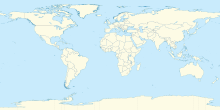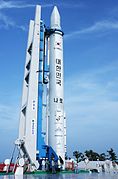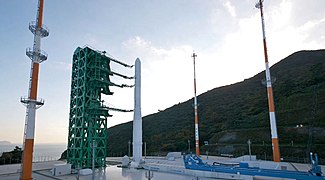Naro Space Center
- View a machine-translated version of the Korean article.
- Machine translation, like DeepL or Google Translate, is a useful starting point for translations, but translators must revise errors as necessary and confirm that the translation is accurate, rather than simply copy-pasting machine-translated text into the English Wikipedia.
- Do not translate text that appears unreliable or low-quality. If possible, verify the text with references provided in the foreign-language article.
- You must provide copyright attribution in the edit summary accompanying your translation by providing an interlanguage link to the source of your translation. A model attribution edit summary is
Content in this edit is translated from the existing Korean Wikipedia article at [[:ko:나로우주센터]]; see its history for attribution. - You may also add the template
{{Translated|ko|나로우주센터}}to the talk page. - For more guidance, see Wikipedia:Translation.



| Naro Space Center | |
| Hangul | 나로우주센터 |
|---|---|
| Hanja | 羅老宇宙센터 |
| Revised Romanization | Naro Uju Senteo |
| McCune–Reischauer | Naro Uju Sentŏ |
Download coordinates as:
- KML
- GPX (all coordinates)
- GPX (primary coordinates)
- GPX (secondary coordinates)
The Naro Space Center is a South Korean spaceport in South Jeolla's Goheung County, operated by the state-run Korea Aerospace Research Institute.
The spaceport is located about 485 km (300 mi) south of Seoul.[1] It includes two launch pads, a control tower, rocket assembly and test facilities, facilities for satellite control testing and assembly, a media center, an electric power station, a space experience hall and a landing field.[2][3] It has supported 5 launches including the KSLV-II launch in 2021, and will support SSLV launches in 2025.
History
Naro-1
The first launch, initially planned for August 19, 2009, was performed on August 25, 2009 using a Russo-South Korean Naro-1 rocket, but failed to reach the desired orbit. Another rocket launch from Naro was planned for May 2010, but delays pushed the launch to June. On June 10, 2010, this second attempt also ended in failure when the rocket lost communications 137 seconds after launch. The South Korean science minister Ahn Byung-man later told reporters that the rocket was believed to have exploded.
A third attempt was made on January 30, 2013 and finally succeeded in putting a satellite into orbit.
KSLV-II TLV
The TLV (Test Launch Vehicle) was the second vehicle to use the Naro Space Center. It was launched on a suborbital mission on November 28, 2018, having a mission objective of qualifying the KRE-075 engine which powers the KSLV-II. The launch was a success. The single-stage TLV rocket reached an altitude of 209 kilometers before splashing down into sea; the flight was 10 minutes long.
Nuri
On 21 October 2021 the Nuri rocket (KSLV-II) was launched on its maiden flight from Naro. The rocket reached the planned altitude but failed to put a dummy satellite payload into orbit due to a problem with the rocket's third stage. While South Korea says it intends to use Nuri to launch satellites exclusively, the test has also been viewed by some experts as part of the country's ongoing efforts to develop ballistic missile capabilities.[4] The second flight of Nuri on 21 June 2022 successfully reached orbit.
Facilities
LC-1 (LB-1)
LC-1, also called LB-1 for the pad itself, is the first pad constructed in the Naro Space Center. It supported 3 Naro-1 launches and the KSLV-II TLV launch. It will also support the SSLV (Small Satellite Launch Vehicle) launches from 2025. It is located at 34°25′54″N 127°32′11″E / 34.431803°N 127.536397°E / 34.431803; 127.536397 (LC-1).
LC-2 (LB-2)
LC-2, also called LB-2 for the pad itself, is the second pad in the Naro Space Center. It supported the first Nuri launch in 2021. Different from LC-1, which doesn't have an umbilical tower, LC-2 has a tower to support the KSLV-II. It is located at 34°25′54″N 127°32′04″E / 34.431636°N 127.534411°E / 34.431636; 127.534411 (LC-2).
-
 Naro-1 at LC-1
Naro-1 at LC-1 -
 Naro-1 at LC-1
Naro-1 at LC-1 -
 KSLV-II TLV at LC-1
KSLV-II TLV at LC-1 -
 Nuri at LC-2
Nuri at LC-2 -
 Nuri at LC-2
Nuri at LC-2
See also
- Korea Aerospace Research Institute
- Korean Astronaut Program
References
- ^ Software glitch halts rocket launch - Yonhap News Agency
- ^ South Korea Begins Construction Of New Space Center – Korean Information Service, SpaceDaily, August 12, 2003
- ^ "Korea to enter space race in 2008", http://www.korea.net/News/News/NewsView.asp?serial_no=20080102014&part=107%7C, Ro Ji-woong Korea.net Staff Writer, 03 January, 2008, accessed October 28, 2008
- ^ "South Korea launches first homegrown space rocket Nuri". BBC News. October 21, 2021. Retrieved November 9, 2021.
External links
- Official Website (English)
- Naro Space Center information page on www.kari.re.kr (Korean)
- Public relations website by Goheung County
- Korea's space program to blast off as space center nears completion
- v
- t
- e
 South Korean space program
South Korean space program- Korea AeroSpace Administration (KASA)
- Korea Aerospace Research Institute (KARI)
- Korea Astronomy and Space Science Institute (KASI)
- Anheung Proving Ground
- Naro Space Center
| KARI |
|
|---|---|
| ADD |
|
| KARI |
|
|---|---|
| ADD |
|
- Agency for Defense Development (ADD)
- KAIST Satellite Technology Research Center (SaTReC)
- National Space Committee
- ROKAF space operations center















